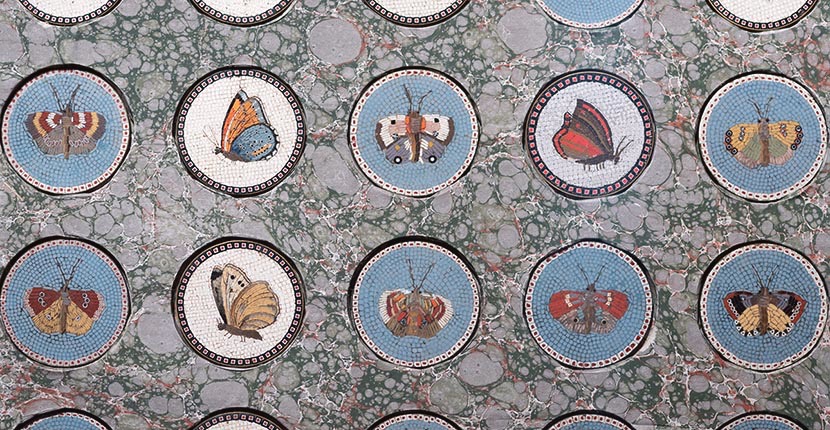
Gallery view of ‘A Return to the Grand Tour’ showing butterfly micromosaics set in a box, ca 1775-1800, attributed to Giacomo Raffaelli, from the collection of Elizabeth Locke. Photo David Stover © Virginia Museum of Fine Arts.
Books & Exhibitions
Micromosaic Jewels Go on Display at the VMFA
The tiny treasures were made for travelers on the Grand Tour
It’s easy to understand why jewelry designer Elizabeth Locke fell in love with micromosaics while she was in the midst of a graduate project in Modern Italian Literature at the University of Florence. The little works of art carry the enchantment of Italy in miniature. They have the same type of dreamy romance that captured the heart of Miss Lucy Honeychurch in E.M Forester’s A Room With A View.
Lucky for all of us, it was not just a passing flirtation for Elizabeth Locke and micromosaics. After she switched careers from being an editor at Town & Country to a jewelry designer in 1989, she once again found herself enchanted by micromosaics. In addition to buying them to set in her jewels she also saved some for her personal collection. Well, she actually saved hundreds.
The best among Locke’s collection are on display until September 2, 2019 at the Virginia Museum of Fine Arts in the exhibition A Return to the Grand Tour: Micromosaic Jewels From the Collection of Elizabeth Locke. The delightful presentation and accompanying 118-page small catalogue that is truly a must have for jewelry lovers, gives a brief history of Locke’s experience and nice review of the history and techniques behind the creation of micromosaics.
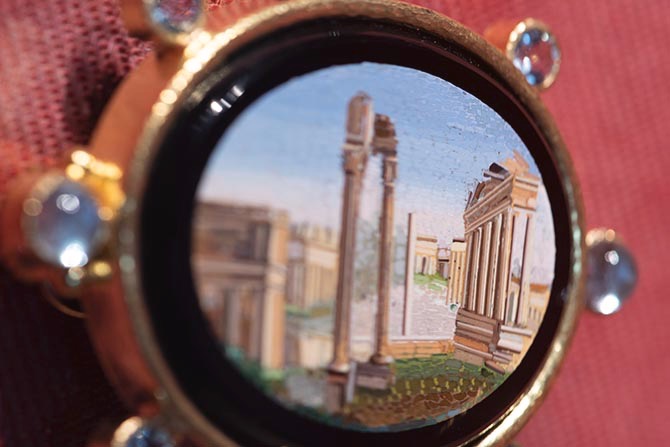
Gallery view of ‘A Return to the Grand Tour’ showing a 19th century micromosaic depicting set in an Elizabeth Locke gold brooch accented with aquamarines. Photo David Stover © Virginia Museum of Fine Arts
Made during the 18th and 19th centuries for well-heeled English travelers on the Grand Tour of Europe, the little creations were souvenirs. The tradition of shrinking down the mosaic concept tourists saw in the large works of art around Italy began in the Vatican Mosaic workshop. By the mid-nineteenth century there were any number of boutiques surrounding the Spanish Steps in Rome that purveyed micromosaics and around 200 artisans living in the Eternal City who made them.
While the technique changed over time, the author of the catalogue and Associate Curator of American Painting and Decorative Art, Susan J. Rawles explains it involved, “the painstaking application of tiny tesserae—small bits of opaque enamel glass—to a prepared surface, commonly copper brushed with a slow-drying adhesive.”
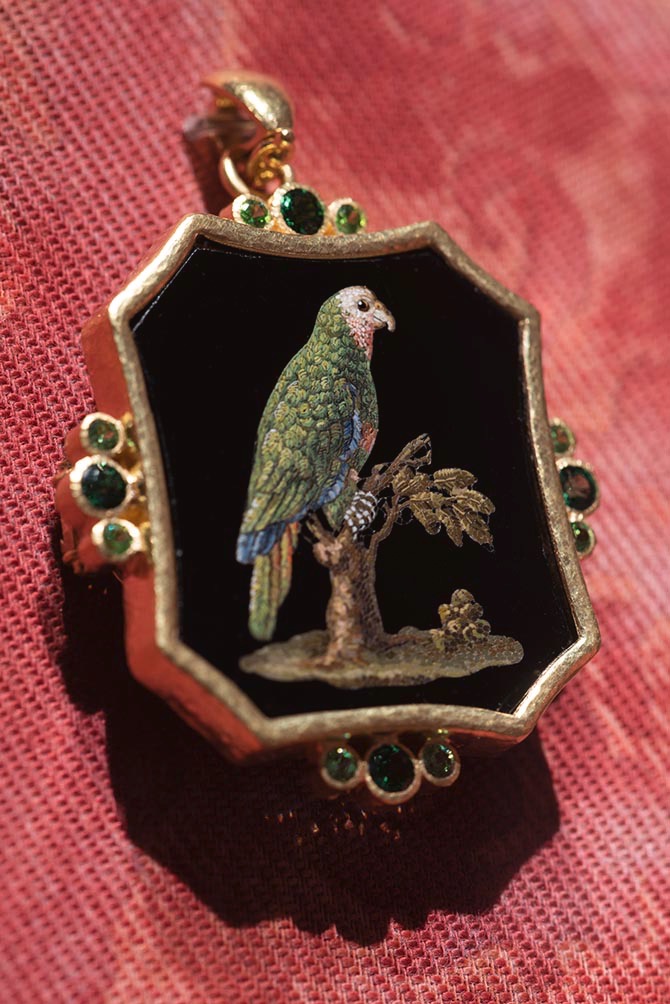
Gallery view of ‘A Return to the Grand Tour’ showing a 19th century micromosaic of a parrot set in an Elizabeth Locke pendant accented with tsavorites and demantoid garnets. Photo: David Stover © Virginia Museum of Fine Arts.
The subjects in the micromosaics form the sections of the exhibition. There are architectural highlights travelers would have enjoyed during their journey such as the Pantheon, the Roman Forum and the Coliseum. Mythological themes form a delightful part of the presentation including Diana in a Chariot Pulled by Deer, a Bacchante and Romulus and Remus. There are also lots of motifs that would have simply charmed the tourists including animals and landscapes.
Some of the micromosaics in the presentation are in jewels that date from the period. The vast majority in the exhibit are shown in modern jewels by Elizabeth Locke. Her signature bold hammered 19K gold settings act as frames for the antiques. The designer explains in the catalogue many mosaics she discovered were not set in jewels others she removed from their original settings for a reason. “I feel that most of the original settings for the micromosaics do not do justice to the beauty and refinement of the art that they surround,” says Locke. “Most are in low-carat gold filigree or have a thin bezel and a pin on the back.”
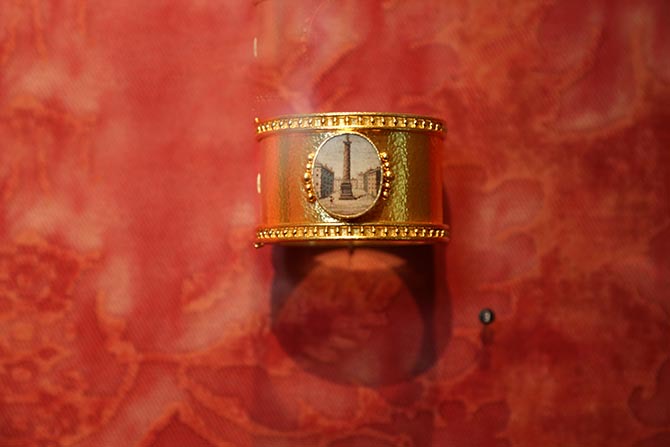
Gallery view of ‘A Return to the Grand Tour’ showing a 19th century micromosaic of the Piazzo del Popolo in Rome set in a bracelet by Elizabeth Locke. Photo: David Stover © Virginia Museum of Fine Arts.
A Return to the Grand Tour: Micromosaic Jewels From the Collection of Elizabeth Locke is a small exhibition that makes an important contribution to the history of jewelry. Micromosaics are a beloved area of the field that are often skated over when they are presented in books or exhibitions in favor of larger works. This presentation and the catalogue give the subject the attention it has deserved for so long.
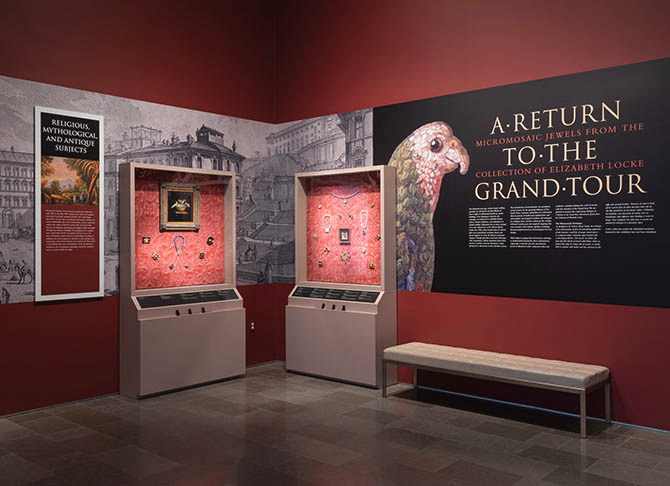
Gallery view of ‘A Return to the Grand Tour: Micromosaic Jewels from the Collection of Elizabeth Locke’ Photo David Stover © Virginia Museum of Fine Arts.
Related Stories:
Elizabeth Locke Explains Her Personal Connection to Jean Schlumberger
New Jewels and Special Treasures at the V & A
The MET Asks: What Is Jewelry?
Get a gem in your mailbox SIGN UP FOR THE ADVENTURINE NEWSLETTER




